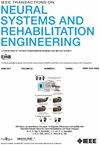An Online Estimating Framework for Ankle Actively Exerted Torque Under Multi-DOF Coupled Dynamic Motions via sEMG
IF 4.8
2区 医学
Q2 ENGINEERING, BIOMEDICAL
IEEE Transactions on Neural Systems and Rehabilitation Engineering
Pub Date : 2024-12-11
DOI:10.1109/TNSRE.2024.3515966
引用次数: 0
Abstract
Ankle rehabilitation robots can offer tailored rehabilitation training, and facilitate the functional recovery of patients. Accurate estimation of the actively exerted torque from the ankle joint complex (AJC) can increase the engagement of patients during rehabilitation training. Given the three degrees of freedom (DOFs) of AJC and its coupled motion, it becomes essential to accurately estimate the actively exerted torque under multi-DOF. This work introduces an estimation framework that includes the Hill-based sEMG-force model, the ankle musculoskeletal dynamic decoupling model, and the parameter identification-calibration strategy. The Hill-based sEMG-force model estimates the force generated by individual muscles involved in AJC; The parameter identification-calibration strategy combined with pre-experiment identifies unknown variables in the ankle musculoskeletal dynamic decoupling model; Finally, the musculoskeletal dynamic decoupling model relates the muscle forces to the AJC’s actively exerted torque. The musculoskeletal dynamic decoupling model combines anatomical and biomechanical features, enabling parameters derived from a single DOF pre-experiment through identification-calibration strategy to be applicable in multi-DOF dynamic motion. To evaluate the estimation performance of the framework, experiments were conducted in various directions involving both single and multiple DOFs. The results show that the proposed framework can estimate the actively exerted torque with a normalized root mean square error (NRMSE) of求助全文
约1分钟内获得全文
求助全文
来源期刊
CiteScore
8.60
自引率
8.20%
发文量
479
审稿时长
6-12 weeks
期刊介绍:
Rehabilitative and neural aspects of biomedical engineering, including functional electrical stimulation, acoustic dynamics, human performance measurement and analysis, nerve stimulation, electromyography, motor control and stimulation; and hardware and software applications for rehabilitation engineering and assistive devices.

 求助内容:
求助内容: 应助结果提醒方式:
应助结果提醒方式:


